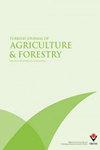Study on heavy metal content calculation and agricultural potential based on hyperspectral remote sensing image processing
IF 3
2区 农林科学
Q1 AGRONOMY
引用次数: 0
Abstract
: Soil is the main influencing factor for plant growth, reproduction, and distribution. With the acceleration of industrialization and the intensification of human activities, the problem of heavy metal pollution in agricultural soil is becoming increasingly prominent. Heavy metals present in soil are toxic and readily absorbed by plants, posing a significant threat to human health when contaminated crops are consumed. Therefore, monitoring the content of heavy metals (referred to as HMs) in soil is imperative. Hyperspectral remote sensing (HRS), owing to its ultrahigh spectral resolution, holds significant promise for acquiring quantitative information on soil organic matter, minerals, and other components. In comparison with traditional detection methods, soil heavy metal inversion based on HRS offers advantages such as rapid, convenient, and large-scale on-site monitoring, demonstrating considerable practical value. This study investigates the monitoring mechanism and feature extraction of HRS technology by analyzing the calculation methods for soil and HM content. In the experimental phase, the HM content in rice and corn crops, paddy soil, and lime soil from 2017 to 2020 was analyzed. Through experimental comparative analysis, it was observed that the HMs enrichment coefficients were 0.987, 1.154, and 0.186 in 2017, 2018, and 2020, respectively. Notably, the smallest HMs enrichment coefficient was recorded in 2020, while the highest was in 2018. The utilization of HRS image processing enhances the accuracy of HM content determination, thus bearing significant implications for assessing soil agricultural potential.基于高光谱遥感图像处理的重金属含量计算及农业潜力研究
:土壤是植物生长、繁殖和分布的主要影响因素。随着工业化进程的加快和人类活动的加剧,农业土壤中的重金属污染问题日益突出。土壤中的重金属具有毒性,易被植物吸收,食用受污染的农作物会对人类健康造成严重威胁。因此,监测土壤中的重金属(简称 HMs)含量势在必行。高光谱遥感技术(HRS)具有超高的光谱分辨率,在获取土壤有机物、矿物质和其他成分的定量信息方面大有可为。与传统的检测方法相比,基于高光谱遥感技术的土壤重金属反演具有快速、便捷和大规模现场监测等优势,具有相当大的实用价值。本研究通过分析土壤和 HM 含量的计算方法,研究了 HRS 技术的监测机制和特征提取。在实验阶段,分析了 2017 年至 2020 年水稻和玉米作物、水稻土、石灰土中的 HM 含量。通过实验对比分析发现,2017 年、2018 年和 2020 年的 HMs 富集系数分别为 0.987、1.154 和 0.186。值得注意的是,2020 年的 HMs 富集系数最小,而 2018 年最高。利用 HRS 图像处理提高了 HMs 含量测定的准确性,从而对评估土壤的农业潜力具有重要意义。
本文章由计算机程序翻译,如有差异,请以英文原文为准。
求助全文
约1分钟内获得全文
求助全文
来源期刊
CiteScore
4.20
自引率
6.90%
发文量
42
审稿时长
12 months
期刊介绍:
The Turkish Journal of Agriculture and Forestry is published electronically 6 times a year by the Scientific and Technological Research Council of Turkey (TÜBİTAK).
It publishes, in English, full-length original research papers and solicited review articles on advances in agronomy, horticulture, plant breeding, plant protection, plant molecular biology and biotechnology, soil science and plant nutrition, bionergy and energy crops, irrigation, agricultural technologies, plant-based food science and technology, forestry, and forest industry products.

 求助内容:
求助内容: 应助结果提醒方式:
应助结果提醒方式:


